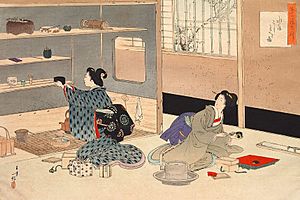Mizuya facts for kids
A mizuya (水屋, "water room") is a special preparation area. It is found in a Japanese tea house (chashitsu) or any place used for the Japanese tea ceremony. Think of it as a "backstage" area for the tea host. Even for outdoor tea ceremonies, the preparation spot is called a mizuya. While the word mizuya can also mean water fountains at temples or kitchen cupboards, this article focuses on the mizuya used for the tea ceremony.
Contents
History of the Tea Room
The Japanese "Way of Tea," called chadō, grew popular in the 1500s. A famous tea master named Sen no Rikyū helped develop it. He also helped create special buildings just for the tea ceremony.
Before these buildings, people would just set up a tea-making corner in a large room. But as the tea ceremony became more detailed, a dedicated "back room" was needed. This space allowed the host to get everything ready for the guests.
One of the oldest examples of a mizuya is at the Taian tea room. Sen no Rikyū himself designed this tea room. Other writings from his teacher, Takeno Jōō, also mention mizuya.
What is a Mizuya Used For?
As its name "water room" suggests, a mizuya is where water-related tasks happen.
- Washing and cleaning the many tea tools.
- Boiling extra water for the tea room.
- Preparing wagashi (Japanese sweets) for guests. This includes cutting them and arranging them on dishes.
- Organizing and storing all the tea supplies.
- Quickly making many bowls of tea for large groups.
Mizuya Facilities and Setup
A mizuya can be very simple or quite fancy. The simplest ones might just have a hot plate and water buckets. These could even be in an outdoor area.
A fully equipped indoor mizuya can be like a modern kitchen. It might have:
- Several sinks with hot and cold water.
- Lots of storage, cupboards, and shelves.
- Worktops for preparing items.
- Sometimes, a refrigerator, stove, or microwave.
Most mizuya are somewhere in between these two extremes.
A typical indoor mizuya often has a special recessed area. This area is called the mizuyanagashi. It might have a tatami mat in front of it. Inside, there is a traditional sink called a nagashi. This is a long metal tub in the floor, covered with a bamboo grate. There are also wooden shelves for supplies and a board with pegs for hanging ladles and towels.
If a permanent mizuyanagashi isn't built in, a portable unit can be used. This is called an okimizuya. No matter the size, a mizuya is always kept very clean and organized. Each tea school has its own way of arranging the tools.
The Special Mizuya Dōko
Some tea rooms have a special built-in cabinet called a mizuya dōko (水屋洞庫). This cabinet is part of the tea room wall, near where the host sits. It has sliding doors that can hide it from guests.
A regular dōko is similar but does not have water drainage. Both dōko and mizuya dōko were created to help hosts who find it hard to sit and stand. This is especially helpful for older hosts who have trouble with the seiza sitting position.
The name dōko comes from the boxes used by puppeteers for their dolls. Sen no Rikyū first used this name for tea cabinets. At first, these cabinets were placed on the floor. Later, they were hung on the wall, and finally, they were built right into the wall.


